![]() 1st Battalion 22nd Infantry
1st Battalion 22nd Infantry ![]()
The 22nd Infantry at Fort McPherson and Fort McClellan 1922-1940
The 22nd Infantry left Fort Jay, New York, in
June of 1922, to be permanently stationed at Fort McPherson,
Georgia,
until July of 1940. A complete history of the 22nd Infantry at Ft
McPherson and Ft McClellan is not available.
Most of the following information and photos are taken from THE
FORT MCPHERSON STORY 1885-1963,
prepared by the Staff History Officer, Office of the Adjutant
General, Headquarters Third United States Army,
Fort McPherson, Georgia in 1964.
Additional photos, comments and information supplied by the website editor.
FORT MCPHERSON AFTER WORLD WAR I
After the First World War, activities at Fort
McPherson expanded and waned as demands on the Army establishment
varied.
On 31 August 1920, the Southeastern Department was discontinued
and effective 1 September 1920 the IV Corps Area was established
comprising the States of North Carolina, South Carolina, Georgia,
Florida, Alabama, Tennessee, Mississippi, Arkansas, and
Louisiana.
From 1920 to 1924 and 1927 to 1934 Fort McPherson served as
headquarters for the entire IV Corps Area.
In 1931, the base hospital was greatly expanded and for several
years the Fort was noted primarily as a rehabilitation center.
Famed troop organizations such as the 22d Infantry, the Eighth
Brigade, and the 6th Infantry were stationed at Fort McPherson.
On 28 September 1920, a general order was published by
Headquarters, IV Corps Area, which closed that headquarters
at Charleston, South Carolina, and opened it at Fort McPherson,
effective at midnight 15 November 1920.
The new National Defense Act of 4 June 1920,
which governed the organization and regulation of the Army until
1950,
has been widely acknowledged to be the most constructive piece of
military legislation ever adopted in the United States.
It rejected the theory of an expansible Regular Army urged since
the days of John C. Calhoun. Instead, it established
the Army of the United States as an organization of three
components, the professional Regular Army, the civilian National
Guard,
and the civilian Organized Reserves (Officers' and Enlisted
Reserve Corps). In contrast to earlier practice, the training of
civilian components
now became a major peacetime task of the Regular Army.
This new concept brought the Regular out of his
traditional isolation from the civilian community and it
acquainted large numbers
of civilians with the problems and views of the professional
soldier. The end result of the civilian training program was an
orderly
and effective mobilization of National Guard and Reserve elements
into the Active Army in 1940 and 1941.
In view of this new concept,the military training
responsibilities of the units stationed at Fort McPherson during
the period
between the two wars changed drastically. Military units at Fort
McPherson still participated in the old standard training
such as military drill, hikes, field problems, target practice,
participation in small maneuvers, training of recruits,
and participation in special events of the Army and civilian
community.
However, during this period the military
personnel of Fort McPherson participated in many new or expanded
military activities
such as conducting training, supervising or inspecting Citizens
Military Training Camps, Reserve Officer Training Corps programs
and summer encampments, Organized Reserve Schools, West Point
preparatory schools, Organized Reserve Corps summer encampments,
and the Civilian Conservation Corps program.
For details on the Citizens Military Training
Camps, and the invovlement of the 22nd Infantry
in that program, see the listings in the HISTORY
section of this website.
FORT MCPHERSON COMMANDERS 1922-1940
LTC W. G. Doane 22nd Infantry |
LTC R. H. Hearn 22nd Infantry |
LTC J.M. Kimbrough 22nd Infantry |
COL D.W. Ryther 22nd Infantry |
COL G. F. Baltzell 22nd Infantry |
COL L.W. Caffey 22nd Infantry |
COL T. S. Moorman 22nd Infantry |
Lt. Col. W. G. Doane * 14 Jun 22 - 23 Oct 22
Lt. Col. Roscoe H. Hearn * 24 Oct 22-4 Feb 23
Lt. Col. James M. Kimbrough * 5 Feb 23 - 31 Dec 23
Col. Dwight W. Ryther * 1 Jan 24 - 31 Oct 25
Brig. Gen. LeRoy Elting 1 Nov 25 - 31 Mar 26
Brig. Gen. J. D. Leitch 1 Apr 26 - 24 Jan 27
Col. George F. Baltzell * 25 Jan 27 - 16 Mar 27
Brig. Gen. H. 0. Williams 17 Mar 27 - 23 Dec 27
Col. George F. Baltzell * 24 Dec 27 - 28 Feb 28
Brig. Gen. A. G. Lott 1 Mar 28 - 30 Aug 29
Col. Lochlin W. Caffey * 31 Aug 29 - 18 Sep 29
Brig. Gen. George H. Estes 19 Sep 29 - 29 Aug 33
Col. Thomas S. Moorman * 30 Aug 33 - 11 Jan 34
Brig. Gen. Robert O. Van Horn 12 Jan 34 - 31 Aug 40
* 22nd Infantry
The following excerpts from the daily reports
of the post are representative of the duties and experiences of
the Regiment while at the Fort.
14 June 1922 -- The 22d
Infantry arrived with a strength of 150 enlisted men and 19
officers and 2 warrant officers.
The regiment was commanded by Lt. Col. W. G. Doane, 22d Infantry,
who assumed command of the Post.
23 June 1926 -- Barracks of Company "M" 22d Infantry, destroyed by fire. Loss $4,000. Origin of fire not determined.
11 October 1927 -- Col. C. A.
Lindbergh arrived in Atlanta at 2:00 P.M. General Williams was on
the reception committee.
The 22d Infantry was assembled at Grant Field as an escort of
honor.
9 April 1928 -- General A. G.
Lott and Staff commanded all troops in morning parade in Atlanta
as part of ceremonies relative to
unveiling of Lee's head on Stone Mountain. 22d Infantry Band, and
Companies "E", "F", and "G", in
command of Maj. J. H. Hester,
participated in this parade. All 22d Infantry troops and General
Lott were at Stone Mountain in afternoon during unveiling
ceremonies.
22d Infantry Band, official band on this occasion. General Lott
and Staff attended banquet given by Old Guard at Atlanta Athletic
Club.
19 May 1928 -- Guard of Honor
for Maj. Gen. R. H. Alien, Chief of Infantry, at 8:30 A.M.
consisting of 2d Bn., 22d Infantry, and a salute of 13 guns
fired.
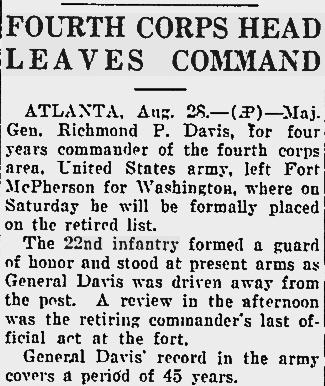
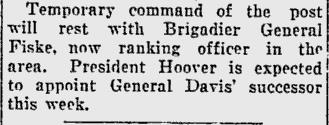
Above article from the Miami News, August 28, 1929
28 November 1928 -- Brigadier
General Harold B. Fiske, U.S. Army, arrived at this station to
assume command
of the Fourth Coast Artillery District. General Fiske was
received by the Post Commander and his staff and customary honors
for a Brigadier General were rendered with the 22d Infantry
furnishing the guard of honor.
13 September 1929 -- At 5:30
A.M., an air mail plane, piloted by Mr. Malloy, struck a radio
mast guide cable, demolished the radio mast
and the airplane. The pilot was extracted from the wreck by
soldiers, and taken to the Station Hospital where he died at 8:30
A.M.,
the same date. An ivestigation of the cause of the crash was made
by Captain Thomas Ramsey, 22d Infantry,
appointed Summary Court for that purpose. The mail was salvaged
by the Postal suthorities.
11 December 1929 -- Brigadier
General Edward L. King, Asst Chief of Staff, G-3, War Department,
visited the Post on a tour of training inspection.
Guard of honor was furnished by the 22d Infantry and appropriate
salute was fired.
6 January 1930 -- Brigadier
General Wallace Duffield Wright, British Army, Retired, visited
the Post.
Guard of Honor was furnished by the 22d Infantry and salute to a
member of the Pariliament, 17 guns, was fired.
21 January 1930 -- Major
General Herbert B. Corsby, U.S.A., Chief of Cavalry, visited the
Post.
Guard of Honor furnished by the 22d Infantry and appropriate
salute fired.
28 February 1930 -- Major
General William G. Everson. Chief of Militia Bureau, Washington,
D.C., visited the Post.
Guard of Honor furnished by the 22d Infantry, and appropriate
salute fired.
16 April 1930 -- Major General
Stephen O. Fuqua, U.S.A., Chief of Infantry, visited the Post on
a tour of inspection.
Guard of Honor furnished by the 22d Infantry, and appropriate
salute was fired.
15 May 1930 -- Major General
Hugh A. Drum, U.S.A., Inspector General, U.S. Army, visited the
Post.
Guard of Honor furnished by the 22d Infantry, and appropriate
salute fired.
26 July 1930 -- Major General
John W. Gulick, U.S.A., Chief of Coast Artillery, visited the
Post.
Guard of Honor furnished by the 22d Infantry and appropriate
salute fired.
11 June 1934 -- First
Presidential salute of 21 guns in Fort McPherson's hitory.
President Roosevelt arrived with Mrs. Roosevelt and son James.
The Roosevelt family visited the home of General Van Horn
Moseley, IV Corps Area Commander.
The 22d Infantry Band played "Hail to the Chief" and
Company G of the 22d Infantry was guard of honor.
13 Jan 1935 -- Dr. Luther,
German Ambassador, visited the Corps Area Commander, 10:30 A.M.;
2d Battalion, 22d Infantry formed Guard of Honor. No salute
fired.
28 February 1935 -- A
detachment of the 22d Infantry, consisting of twenty-seven (27)
enlisted men left this station for Fort McClellan, Alabama,
for permanent station, preparatory to the permanent change of
station of Regimental Headquarters,
Headquarters and Service Companies, 22d Infantry, to Fort
McClellan, Alabama.
June 1940 -- Colonel George H. Weems takes command of the 22nd Infantry
July 1940 -- The 22d Infantry was transferred permanently to Fort McClellan, Alabama. They were replaced by the 62d Signal Battalion.
September 1940 -- The 22nd Infantry was transferred to Fort Benning, Georgia
|
Private Lucas Neas of
Company F 22nd Infantry
Private Neas was born in Johnson City, Tennessee. |
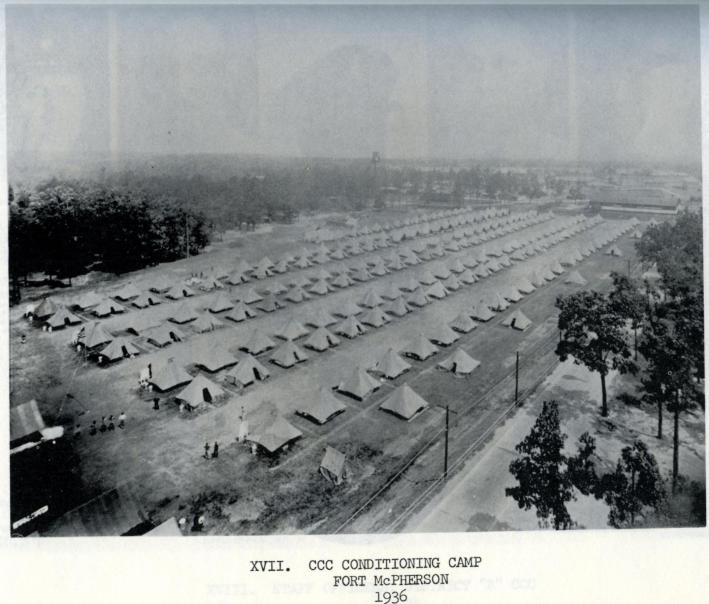
CIVILIAN CONSERVATION CORPS ( CCC )
When Franklin D. Roosevelt became President, he
made a major effort to relieve unemployment. In response to his
suggestion,
Congress enacted legislation in March 1933 establishing the
Civilian Conservation Corps. On 10 April, the President made a
major change
in the original plan and directed the Army to assume, under the
general supervision of the Director of the Civilian Conservation
Corps,
complete and permanent control of the CCC project, except for the
functions of selecting recruits and supervising technical work in
the forests.
During the period 1933 to 1942, the Civilian
Conservation Corps program was one of the major activities of the
post of Fort McPherson
and of Headquarters, IV Corps Area, as well.
On 22 May 1933, District "B" Civilian
Conservation Corps, IV Corps area, was established with
headquarters at Fort McPherson.
Concurrent with this action the post commander of Fort McPherson,
Brig. Gen. George H. Estes, was also designated as the commander
of District "B". General Estes designated 1st Lt.
Charles R. Landon, Infantry ADC, as adjutant; Capt. Mark V.
Brunson, QMC,
as district quartermaster, and Col. John C. Clark, Medical Corps,
as district surgeon.
Practically every officer of the 22d Infantry
stationed at Fort McPherson was withdrawn from his regular duties
with troops
and most of the noncommissioned officers and many of the privates
of the 22d Infantry were called on for temporary duty with the
CCC.
In August, General Estes was transferred to
command the Infantry School at Fort Benning. Col. T. S. Moorman,
Commanding Officer,
22d Infantry, became the District Commander of District
"B".
In January 1934 Brig. Gen. Robert 0. Van Horn,
USA, reported for duty at Fort McPherson in compliance with War
Department orders
and became District Commander of District "B".
On 1 October 1934, 45 additional Reserve
officers reported for duty in District "B" and after a
short period of instruction
were sent to the work camps, thus making it possible to relieve
practically all the Regular Army officers on duty with District
"B".
In addition to the support of the military and
civilian personnel of Fort McPherson, in initiating the CCC
program,
Company E, 22d Infantry departed from this station on 20 April
1933 for Camp Beauregard, Louisiana, to participate in the
program
at that station and did not return until 28 September 1933.
Within a few minutes after the President, as
Commander-in-Chief, had given his orders to the Secretary of War
and Chief of Staff
the immense army radio control station in Washington began to
send out orders and instructions and almost within the hour
every military post in the country vas buzzing with activity.
Perhaps one of the most interesting and
important features of the operation of District "B" was
the system by which the camps in the district
were supplied from the district supply depot located at Fort
McPherson. This was effected by a motor convoy system,
the district being divided into five supply areas, each one was
served once each month by the motor convoy consisting of
approximately thirty 1½-ton trucks. This convoy delivered more
than 300 tons per month of supplies of every description to the
camps of this district.
The physical welfare of the men of District
"B" was handled by an efficient corps of medical
officers stationed at the various camps.
Those men who required hospital treatment were evacuated to the
hospital station at Fort McPherson by motor ambulance.
By direction of the President, the calling of
additional Reserve officers to active duty with the CCC was
suspended on l6 June 1939;
they were to be replaced by civilian employees by 31 December
1939 and the CCC Program was removed from Army control
and placed under the control of the Department of Interior.
Accordingly, all Reserve officers on CCC duty were relieved from
active duty
and placed on a civilian status by 31 December 1939. On 30 June
1941 there were 77 Regular Army officers and 3,l89 members
of the Reserve Corps in a civilian status on duty with the CCC.
Some twenty-seven CCC companies were then assisting
in the expanding national defense program by clearing and
developing maneuver and training areas at various military
reservations.
The CCC was suspended in 1942.
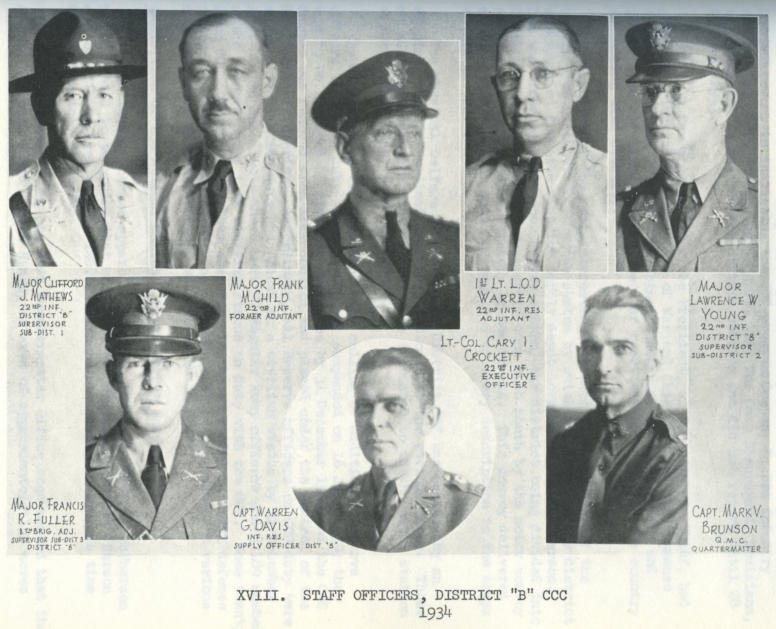
Staff Officers of District
"B" of the CCC, 1934 - five of the eight officers
comprising the Staff are from the 22nd Infantry. They are the
five officers
in the top row of the above photo.
Flyer advertising a boxing match at Fort McPherson. Date unknown. This was for the first night of
boxing matches Unfortunately, it is unknown if
The text inside the photo of the boxer reads: Welterweight Champion |
|
Bottom part of Court Martial
procedure papers |
LTC Cary I. Crockett 22nd Infantry |
|
Cover of Thanksgiving Dinner menu of Company G 22nd Infantry 1930 Fort McPherson |
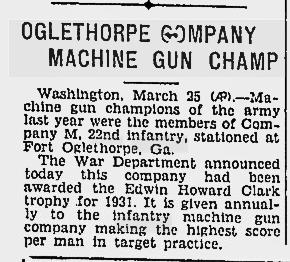
Above article from the Herald-Journal, March 26, 1932
Fort Oglethorpe was in Catoosa &
Walker Counties in the
upper northwest of Georgia.
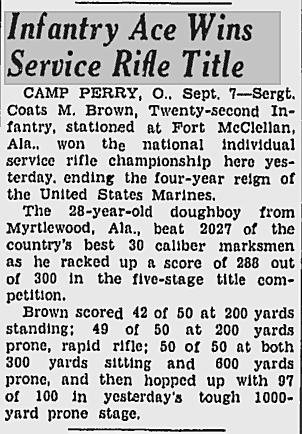
From the Berkeley Daily Gazette September 5, 1939
Home | Photos | Battles & History | Current |
Rosters & Reports | Medal of Honor | Killed
in Action |
Personnel Locator | Commanders | Station
List | Campaigns |
Honors | Insignia & Memorabilia | 4-42
Artillery | Taps |
What's New | Editorial | Links |